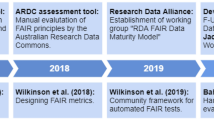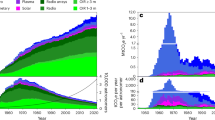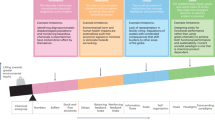Abstract
The carbon footprint of scientific computing is substantial, but environmentally sustainable computational science (ESCS) is a nascent field with many opportunities to thrive. To realize the immense green opportunities and continued, yet sustainable, growth of computer science, we must take a coordinated approach to our current challenges, including greater awareness and transparency, improved estimation and wider reporting of environmental impacts. Here, we present a snapshot of where ESCS stands today and introduce the GREENER set of principles, as well as guidance for best practices moving forward.
This is a preview of subscription content, access via your institution
Access options
Access Nature and 54 other Nature Portfolio journals
Get Nature+, our best-value online-access subscription
$29.99 / 30 days
cancel any time
Subscribe to this journal
Receive 12 digital issues and online access to articles
$99.00 per year
only $8.25 per issue
Buy this article
- Purchase on SpringerLink
- Instant access to full article PDF
Prices may be subject to local taxes which are calculated during checkout

Similar content being viewed by others
References
NIHR Carbon Reduction Guidelines (National Institute for Health and Care Research, 2019); https://www.nihr.ac.uk/documents/nihr-carbon-reduction-guidelines/21685
NHS Becomes the World’s First National Health System to Commit to Become ‘Carbon Net Zero’, Backed by Clear Deliverables and Milestones (NHS England, 2020); https://www.england.nhs.uk/2020/10/nhs-becomes-the-worlds-national-health-system-to-commit-to-become-carbon-net-zero-backed-by-clear-deliverables-and-milestones/
Climate and COVID-19: converging crises. Lancet 397, 71 (2021).
Marazziti, D. et al. Climate change, environment pollution, COVID-19 pandemic and mental health. Sci. Total Environ. 773, 145182 (2021).
Wellcome Commissions Report on Science’s Environmental Impact (Wellcome, 2022); https://wellcome.org/news/wellcome-commissions-report-sciences-environmental-impact
Towards Climate Sustainability of the Academic System in Europe and Beyond (ALLEA, 2022); https://doi.org/10.26356/climate-sust-acad
Klöwer, M., Hopkins, D., Allen, M. & Higham, J. An analysis of ways to decarbonize conference travel after COVID-19. Nature 583, 356–359 (2020).
Allen, M. R. et al. A solution to the misrepresentations of CO2-equivalent emissions of short-lived climate pollutants under ambitious mitigation. npj Clim. Atmos. Sci. 1, 16 (2018).
Nathans, J. & Sterling, P. How scientists can reduce their carbon footprint. eLife 5, e15928 (2016).
Helmers, E., Chang, C. C. & Dauwels, J. Carbon footprinting of universities worldwide part II: first quantification of complete embodied impacts of two campuses in Germany and Singapore. Sustainability 14, 3865 (2022).
Marshall-Cook, J. & Farley, M. Sustainable Science and the Laboratory Efficiency Assessment Framework (LEAF) (UCL, 2023).
Mariette, J. et al. An open-source tool to assess the carbon footprint of research. Environ. Res. Infrastruct. Sustain. 2, 035008 (2022).
Murray, D. S. et al. The environmental responsibility framework: a toolbox for recognizing and promoting ecologically conscious research. Earth’s Future 11, e2022EF002964 (2023).
Freitag, C. et al. The real climate and transformative impact of ICT: a critique of estimates, trends and regulations. Patterns 2, 100340 (2021).
Ritchie, H. Climate change and flying: what share of global CO2 emissions come from aviation? Our World in Data (22 October 2022); https://ourworldindata.org/co2-emissions-from-aviation
Feng, W. & Cameron, K. The Green500 list: encouraging sustainable supercomputing. Computer 40, 50–55 (2007).
Garg, S. K., Yeo, C. S., Anandasivam, A. & Buyya, R. Environment-conscious scheduling of HPC applications on distributed cloud-oriented data centers. J. Parallel Distrib. Comput. 71, 732–749 (2011).
Katal, A., Dahiya, S. & Choudhury, T. Energy efficiency in cloud computing data centers: a survey on software technologies. Clust. Comput. https://doi.org/10.1007/s10586-022-03713-0 (2022).
Strubell, E., Ganesh, A. & McCallum, A. Energy and policy considerations for deep learning in NLP. In Proc. 57th Annual Meeting of the Association for Computational Linguistics 3645–3650 (Association for Computational Linguistics, 2019); https://doi.org/10.18653/v1/P19-1355
Schwartz, R., Dodge, J., Smith, N. A. & Etzioni, O. Green AI. Preprint at https://arxiv.org/abs/1907.10597 (2019).
Lacoste, A., Luccioni, A., Schmidt, V. & Dandres, T. Quantifying the carbon emissions of machine learning. Preprint at https://arxiv.org/abs/1910.09700 (2019).
Bender, E. M., Gebru, T., McMillan-Major, A. & Shmitchell, S. On the dangers of stochastic parrots: can language models be too big? In Proc. 2021 ACM Conference on Fairness, Accountability and Transparency 610–623 (Association for Computing Machinery, 2021); https://doi.org/10.1145/3442188.3445922
Memmel, E., Menzen, C., Schuurmans, J., Wesel, F. & Batselier, K. Towards Green AI with tensor networks—sustainability and innovation enabled by efficient algorithms. Preprint at https://doi.org/10.48550/arXiv.2205.12961 (2022).
Grealey, J. et al. The carbon footprint of bioinformatics. Mol. Biol. Evol. 39, msac034 (2022).
Burtscher, L. et al. The carbon footprint of large astronomy meetings. Nat. Astron. 4, 823–825 (2020).
Jahnke, K. et al. An astronomical institute’s perspective on meeting the challenges of the climate crisis. Nat. Astron. 4, 812–815 (2020).
Stevens, A. R. H., Bellstedt, S., Elahi, P. J. & Murphy, M. T. The imperative to reduce carbon emissions in astronomy. Nat. Astron. 4, 843–851 (2020).
Portegies Zwart, S. The ecological impact of high-performance computing in astrophysics. Nat. Astron. 4, 819–822 (2020).
Bloom, K. et al. Climate impacts of particle physics. Preprint at https://arxiv.org/abs/2203.12389 (2022).
Aron, A. R. et al. How can neuroscientists respond to the climate emergency? Neuron 106, 17–20 (2020).
Leslie, D. Don’t ‘Research Fast and Break Things’: on the Ethics of Computational Social Science (Zenodo, 2022); https://doi.org/10.5281/zenodo.6635569
Samuel, G. & Lucassen, A. M. The environmental sustainability of data-driven health research: a scoping review. Digit. Health 8, 205520762211112 (2022).
Al Kez, D., Foley, A. M., Laverty, D., Del Rio, D. F. & Sovacool, B. Exploring the sustainability challenges facing digitalization and internet data centers. J. Clean. Prod. 371, 133633 (2022).
Digital Technology and the Planet—Harnessing Computing to Achieve Net Zero (The Royal Society, 2020); https://royalsociety.org/topics-policy/projects/digital-technology-and-the-planet/
Lannelongue, L., Grealey, J. & Inouye, M. Green algorithms: quantifying the carbon footprint of computation. Adv. Sci. 8, 2100707 (2021).
Henderson, P. et al. Towards the systematic reporting of the energy and carbon footprints of machine learning. J. Mach. Learn. Res. 21, 10039–10081 (2020).
Anthony, L. F. W., Kanding, B. & Selvan, R. Carbontracker: tracking and predicting the carbon footprint of training deep learning models. Preprint at https://arxiv.org/abs/2007.03051 (2020).
Lannelongue, L., Grealey, J., Bateman, A. & Inouye, M. Ten simple rules to make your computing more environmentally sustainable. PLoS Comput. Biol. 17, e1009324 (2021).
Valeye, F. Tracarbon. GitHub https://github.com/fvaleye/tracarbon (2022).
Trébaol, T. CUMULATOR—a Tool to Quantify and Report the Carbon Footprint of Machine Learning Computations and Communication in Academia and Healthcare (École Polytechnique Fédérale de Lausanne, 2020).
Cloud Carbon Footprint —An open source tool to measure and analyze cloud carbon emissions. https://www.cloudcarbonfootprint.org/ (2023).
Children and Digital Dumpsites: E-Waste Exposure and Child Health (World Health Organization, 2021); https://apps.who.int/iris/handle/10665/341718
Sepúlveda, A. et al. A review of the environmental fate and effects of hazardous substances released from electrical and electronic equipments during recycling: examples from China and India. Environ. Impact Assess. Rev. 30, 28–41 (2010).
Franssen, T. & Johnson, H. The Implementation of LEAF at Public Research Organisations in the Biomedical Sciences: a Report on Organisational Dynamics (Zenodo, 2021); https://doi.org/10.5281/ZENODO.5771609
DHCC Information, Measurement and Practice Action Group. A Researcher Guide to Writing a Climate Justice Oriented Data Management Plan (Zenodo, 2022); https://doi.org/10.5281/ZENODO.6451499
UKRI. UKRI Grant Terms and Conditions (UKRI, 2022); https://www.ukri.org/wp-content/uploads/2022/04/UKRI-050422-FullEconomicCostingGrantTermsConditionsGuidance-Apr2022.pdf
Carbon Offset Policy for Travel—Grant Funding (Wellcome, 2021); https://wellcome.org/grant-funding/guidance/carbon-offset-policy-travel
Juckes, M., Pascoe, C., Woodward, L., Vanderbauwhede, W. & Weiland, M. Interim Report: Complexity, Challenges and Opportunities for Carbon Neutral Digital Research (Zenodo, 2022); https://zenodo.org/record/7016952
Thakur, M. et al. EMBL’s European Bioinformatics Institute (EMBL-EBI) in 2022. Nucleic Acids Res 51, D9–D17 (2022).
Varadi, M. et al. AlphaFold Protein Structure Database: massively expanding the structural coverage of protein-sequence space with high-accuracy models. Nucleic Acids Res. 50, D439–D444 (2022).
Wilkinson, M. D. et al. The FAIR Guiding Principles for scientific data management and stewardship. Sci. Data 3, 160018 (2016).
Bichsel, J. Research Computing: The Enabling Role of Information Technology (Educause, 2012); https://library.educause.edu/resources/2012/11/research-computing-the-enabling-role-of-information-technology
Creutzig, F. et al. Digitalization and the Anthropocene. Annu. Rev. Environ. Resour. 47, 479–509 (2022).
Yang, L. & Chen, J. A comprehensive evaluation of microbial differential abundance analysis methods: current status and potential solutions. Microbiome 10, 130 (2022).
Qin, Y. et al. Combined effects of host genetics and diet on human gut microbiota and incident disease in a single population cohort. Nat. Genet. 54, 134–142 (2022).
Lannelongue, L. & Inouye, M. Inference Mechanisms and Prediction of Protein-Protein Interactions. Preprint at http://biorxiv.org/lookup/doi/10.1101/2022.02.07.479382 (2022).
Dubois, F. The Vehicle Routing Problem for Flash Floods Relief Operations (Univ. Paul Sabatier, 2022).
Thiele, L., Cranmer, M., Coulton, W., Ho, S. & Spergel, D. N. Predicting the thermal Sunyaev-Zel'dovich field using modular and equivariant set-based neural networks. Preprint at https://arxiv.org/abs/2203.00026 (2022).
Armstrong, G. et al. Efficient computation of Faith’s phylogenetic diversity with applications in characterizing microbiomes. Genome Res. 31, 2131–2137 (2021).
Mbatchou, J. et al. Computationally efficient whole-genome regression for quantitative and binary traits. Nat. Genet. 53, 1097–1103 (2021).
Estien, C. O., Myron, E. B., Oldfield, C. A. & Alwin, A. & Ecological Society of America Student Section Virtual scientific conferences: benefits and how to support underrepresented students. Bull. Ecol. Soc. Am. 102, e01859 (2021).
University of Cambridge. Guidelines for Sustainable Business Travel (Univ. Cambridge, 2022); https://www.environment.admin.cam.ac.uk/files/guidelines_for_sustainable_business_travel_approved.pdf
Patterson, D. et al. Carbon emissions and large neural network training. Preprint at https://arxiv.org/abs/2104.10350 (2021).
Patterson, D. et al. The carbon footprint of machine learning training will plateau, then shrink. Computer 55, 18–28 (2022).
Neuroimaging Pipeline Carbon Tracker Toolboxes (OHBM SEA-SIG, 2023); https://ohbm-environment.org/carbon-tracker-toolboxes/
Lannelongue, L. Green Algorithms for High Performance Computing (GitHub, 2022); https://github.com/Llannelongue/GreenAlgorithms4HPC
Carbon Footprint Reporting—Customer Carbon Footprint Tool (Amazon Web Services, 2023); https://aws.amazon.com/aws-cost-management/aws-customer-carbon-footprint-tool/
Lannelongue, L. & Inouye, M. Carbon footprint estimation for computational research. Nat. Rev. Methods Prim. 3, 9 (2023).
Cutress, I. Why Intel Processors Draw More Power Than Expected: TDP and Turbo Explained (Anandtech, 2018); https://www.anandtech.com/show/13544/why-intel-processors-draw-more-power-than-expected-tdp-turbo
Efficiency. Google Data Centers https://www.google.com/about/datacenters/efficiency/
Uptime Institute Releases 2021 Global Data Center Survey (Facility Executive, 2021); https://facilityexecutive.com/2021/09/uptime-institute-releases-2021-global-data-center-survey/
Zoie, R. C., Mihaela, R. D. & Alexandru, S. An analysis of the power usage effectiveness metric in data centers. In Proc. 2017 5th International Symposium on Electrical and Electronics Engineering (ISEEE) 1–6 (IEEE, 2017); https://doi.org/10.1109/ISEEE.2017.8170650
Yuventi, J. & Mehdizadeh, R. A critical analysis of power usage effectiveness and its use in communicating data center energy consumption. Energy Build. 64, 90–94 (2013).
Avelar, V., Azevedo, D. & French, A. (eds) PUE: A Comprehensive Examination of the Metric White Paper No. 49 (Green Grid, 2012).
Power Usage Effectiveness (PUE) (ISO/IEC); https://www.iso.org/obp/ui/#iso:std:iso-iec:30134:-2:ed-1:v1:en
2022 Country Specific Electricity Grid Greenhouse Gas Emission Factors (Carbon Footprint, 2023); https://www.carbonfootprint.com/docs/2023_02_emissions_factors_sources_for_2022_electricity_v10.pdf
Kamiya, G. The Carbon Footprint of Streaming Video: Fact-Checking the Headlines—Analysis (IEA, 2020); https://www.iea.org/commentaries/the-carbon-footprint-of-streaming-video-fact-checking-the-headlines
Rot, A., Chrobak, P. & Sobinska, M. Optimisation of the use of IT infrastructure resources in an institution of higher education: a case study. In Proc. 2019 9th International Conference on Advanced Computer Information Technologies (ACIT) 171–174 (IEEE, 2019); https://doi.org/10.1109/ACITT.2019.8780018
Clément, L.-P. P.-V. P., Jacquemotte, Q. E. S. & Hilty, L. M. Sources of variation in life cycle assessments of smartphones and tablet computers. Environ. Impact Assess. Rev. 84, 106416 (2020).
Kamal, K. Y. The silicon age: trends in semiconductor devices industry. JESTR 15, 110–115 (2022).
Gåvertsson, I., Milios, L. & Dalhammar, C. Quality labelling for re-used ICT equipment to support consumer choice in the circular economy. J. Consum. Policy 43, 353–377 (2020).
Intel Corporate Responsibility Report 2021–2022 (Intel, 2022); https://csrreportbuilder.intel.com/pdfbuilder/pdfs/CSR-2021-22-Full-Report.pdf
TSMC Task Force on Climate-related Financial Disclosures (TSMC, 2020); https://esg.tsmc.com/download/file/TSMC_TCFD_Report_E.pdf
Bycroft, C. et al. The UK Biobank resource with deep phenotyping and genomic data. Nature 562, 203–209 (2018).
UK Biobank Creates Cloud-Based Health Data Analysis Platform to Unleash the Imaginations of the World’s Best Scientific Minds (UK Biobank, 2020); https://www.ukbiobank.ac.uk/learn-more-about-uk-biobank/news/uk-biobank-creates-cloud-based-health-data-analysis-platform-to-unleash-the-imaginations-of-the-world-s-best-scientific-minds
Jackson, K. A picture is worth a petabyte of data. Science Node (5 June 2019).
Nguyen, B. H. et al. Architecting datacenters for sustainability: greener data storage using synthetic DNA. In Proc. Electronics Goes Green 2020 (ed. Schneider-Ramelow, F.) 105 (Fraunhofer, 2020).
Seagate Product Sustainability (Seagate, 2023); https://www.seagate.com/gb/en/global-citizenship/product-sustainability/
Madden, S. & Pollard, C. Principles and Best Practices for Trusted Research Environments (NHS England, 2021); https://transform.england.nhs.uk/blogs/principles-and-practice-for-trusted-research-environments/
Jones, K. H., Ford, D. V., Thompson, S. & Lyons, R. A profile of the SAIL Databank on the UK secure research platform. Int. J. Popul. Data Sci. 4, 1134 (2020).
About the Secure Research Service (Office for National Statistics); https://www.ons.gov.uk/aboutus/whatwedo/statistics/requestingstatistics/secureresearchservice/aboutthesecureresearchservice
Shehabi, A. et al. United States Data Center Energy Usage Report Report no. LBNL-1005775, 1372902 (Office of Scientific and Technical Information, 2016); http://www.osti.gov/servlets/purl/1372902/
Masanet, E., Shehabi, A., Lei, N., Smith, S. & Koomey, J. Recalibrating global data center energy-use estimates. Science 367, 984–986 (2020).
Caplan, T. Help Us Advance Environmentally Sustainable Research (Wellcome, 2022); https://medium.com/wellcome-data/help-us-advance-environmentally-sustainable-research-3c11fe2a8298
Choueiry, G. Programming Languages Popularity in 12,086 Research Papers (Quantifying Health, 2023); https://quantifyinghealth.com/programming-languages-popularity-in-research/
Pereira, R. et al. Ranking programming languages by energy efficiency. Sci. Comput. Program. 205, 102609 (2021).
Lin, Y. & Danielsson, J. Choosing a Numerical Programming Language for Economic Research: Julia, MATLAB, Python or R (Centre for Economic Policy Research, 2022); https://cepr.org/voxeu/columns/choosing-numerical-programming-language-economic-research-julia-matlab-python-or-r
Appuswamy, R., Olma, M. & Ailamaki, A. Scaling the memory power wall with DRAM-aware data management. In Proc. 11th International Workshop on Data Management on New Hardware 1–9 (ACM, 2015); https://doi.org/10.1145/2771937.2771947
Guo, B., Yu, J., Yang, D., Leng, H. & Liao, B. Energy-efficient database systems: a systematic survey. ACM Comput. Surv. 55, 111 (2022).
Karyakin, A. & Salem, K. An analysis of memory power consumption in database systems. In Proc. 13th International Workshop on Data Management on New Hardware—DAMON ’17 1–9 (ACM Press, 2017); https://doi.org/10.1145/3076113.3076117
Karyakin, A. & Salem, K. DimmStore: memory power optimization for database systems. Proc. VLDB Endow. 12, 1499–1512 (2019).
Caset, F., Boussauw, K. & Storme, T. Meet & fly: sustainable transport academics and the elephant in the room. J. Transp. Geogr. 70, 64–67 (2018).
Govaart, G. H., Hofmann, S. M. & Medawar, E. The sustainability argument for open science. Collabra Psychol. 8, 35903 (2022).
Cockrell, H. C. et al. Environmental impact of telehealth use for pediatric surgery. J. Pediatr. Surg. 57, 865–869 (2022).
Alshqaqeeq, F., McGuire, C., Overcash, M., Ali, K. & Twomey, J. Choosing radiology imaging modalities to meet patient needs with lower environmental impact. Resour. Conserv. Recycl. 155, 104657 (2020).
Sustainability Annual Report 2020–2021 (NHS, 2021); https://digital.nhs.uk/about-nhs-digital/corporate-information-and-documents/sustainability/sustainability-reports/sustainability-annual-report-2020-21
UNESCO Recommendation on Open Science (UNESCO, 2021); https://en.unesco.org/science-sustainable-future/open-science/recommendation
Samuel, G. & Richie, C. Reimagining research ethics to include environmental sustainability: a principled approach, including a case study of data-driven health research. J. Med. Ethics https://doi.org/10.1136/jme-2022-108489 (2022).
Acknowledgements
L.L. was supported by the University of Cambridge MRC DTP (MR/S502443/1) and the BHF program grant (RG/18/13/33946). M.I. was supported by the Munz Chair of Cardiovascular Prediction and Prevention and the NIHR Cambridge Biomedical Research Centre (BRC-1215-20014; NIHR203312). M.I. was also supported by the UK Economic and Social Research 878 Council (ES/T013192/1). This work was supported by core funding from the British Heart Foundation (RG/13/13/30194; RG/18/13/33946) and the NIHR Cambridge Biomedical Research Centre (BRC-1215-20014; NIHR203312). The views expressed are those of the author(s) and not necessarily those of the NIHR or the Department of Health and Social Care. This work was also supported by Health Data Research UK, which is funded by the UK Medical Research Council, Engineering and Physical Sciences Research Council, Economic and Social Research Council, Department of Health and Social Care (England), Chief Scientist Office of the Scottish Government Health and Social Care Directorates, Health and Social Care Research and Development Division (Welsh Government), Public Health Agency (Northern Ireland) and the British Heart Foundation and Wellcome.
Author information
Authors and Affiliations
Contributions
L.L. conceived and coordinated the manuscript. M.I. organized and edited the manuscript. All authors contributed to the writing and revision of the manuscript.
Corresponding author
Ethics declarations
Competing interests
The authors declare no competing interests.
Peer review
Peer review information
Nature Computational Science thanks Bernabe Dorronsoro and Kirk Cameron for their contribution to the peer review of this work. Primary Handling Editors: Kaitlin McCardle and Ananya Rastogi, in collaboration with the Nature Computational Science team.
Additional information
Publisher’s note Springer Nature remains neutral with regard to jurisdictional claims in published maps and institutional affiliations.
Rights and permissions
Springer Nature or its licensor (e.g. a society or other partner) holds exclusive rights to this article under a publishing agreement with the author(s) or other rightsholder(s); author self-archiving of the accepted manuscript version of this article is solely governed by the terms of such publishing agreement and applicable law.
About this article
Cite this article
Lannelongue, L., Aronson, HE.G., Bateman, A. et al. GREENER principles for environmentally sustainable computational science. Nat Comput Sci 3, 514–521 (2023). https://doi.org/10.1038/s43588-023-00461-y
Received:
Accepted:
Published:
Issue Date:
DOI: https://doi.org/10.1038/s43588-023-00461-y



